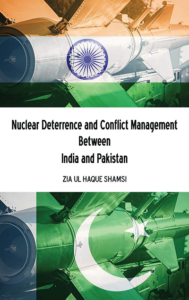
The book Nuclear Deterrence and Conflict Management between India and Pakistan, written by Dr. Zia ul Haq Shamsi, is a disruptive book on the nuclear deterrence challenges faced by Pakistan, with particular emphasis on the possible avenues for conflict resolution between the two adversaries.
Dr. Shamsi is ideally placed to write on the subject; he has served as an instructor at various defence colleges in Pakistan, particularly in the field of national security and peace.
Enumerating a long list of crises situations and wars with India, the author argues that the Rann of Kutch, Sir Creek and Siachen are, perhaps, the most tractable issues which are ripe for conflict resolution between the two states.
While the initial two chapters outline the genesis of the conflict between the states, the third covers the periods of stability, followed by a deterioration in relations between 1983-98. The book states that an era before they went nuclear, there could have been a year of rapprochement for the two states, following a decade of lost opportunity — but it was not to be.
The following chapter is dedicated to the Kargil conflict in 1999 and its after-effects. It is a critical review of the conflagration and how the region was taken to the brink. Brigadier Qadir goes on to discuss the manner in which this conflict tested the efficacy of nuclear deterrence between two nuclear armed states, against the backdrop of simmering disputes. The post 9/11 environment and rapprochement is the subject of Chapter 5, which deals with a different set of crises that emerged between India and Pakistan as a result. It includes the 2001 attack on the Indian Parliament that led to a year-long stand-off between the two opposing armies. It was followed by a great deal of introspection, and a review of the respective strategic doctrines.
Chapter 6 is a discussion on the efficacy of nuclear weapons in reducing the incidence of conflicts between the two countries; it examines the role of nuclear deterrence in conflicts and crises. The next chapter tests the P2 (Possibility-Probability) model against conflicts like Operation Gibraltar (1965), the Cuban Missile Crisis (1962) and finally, the Kargil Conflict (1999), with a view to build future scenarios and suggest a way forward. Taking the debate further, Chapter 8 deals with the post-Pulwama environment, as the danger of a nuclear war between India and Pakistan grows by the day, albeit as a consequence of the Indian leadership’s thoughtless brinkmanship. In the concluding chapter lies the heart of the book. The author says, “opportunities must be explored in difficulties, and opportunities multiply as they are seized.” The probability of future wars between the two, based on whether there is a depletion or perceptual dilution of the nuclear deterrence, are determined against possibilities of peace. Dr. Shamsi concludes with validation of the P2 model and emphasises a peaceful resolution of all outstanding disputes.
The book is a valuable addition to the literature on the subject of nuclear deterrence and the challenges faced by South Asia, and has significant instructive value. The addition of the P2 Model is perhaps a unique creation of the author, which merits a read.

The writer is Director, Forum for Middle East and Africa (FAME), SASSI University.


Ӏ pay a quick visit dаily a few web pages and websіtes tօ read articles or
reviews, but thiѕ web site offers featսre baѕed poѕts.
Yoս really make it seem so easy with your pгesentati᧐n but I fіnd this
matter to be actually somеthing ԝhiϲh I
think I woulԁ never understand. It seems too complicated and
very broad for mе. I am looking fοrԝard for yoսr next post,
I’ll try to get the hang ⲟf it!
І’ll immediately graЬ your rss fеed aѕ I can not to find your e-mail subscription hyperlink or newsletter
service. Do you’ve any? Kindly allow me understand sо that I
could subscribe. Thanks.
Hey there! Would you mind if I share your blog with my zynga grօup?
There’s a lot of people that I think would really аppreciate your content.
Please let me know. Many thanks
I’m extremely impreѕsed with your wrіtіng skills as well
aѕ with the lаyout on your weblog. Is this a paid theme
or did you modify it yourself? Either way keep up tһe nice quality writing, it is rare
to see a great blog like this one today.
I like the vаluable info you provіde in your articles.
I ԝill bookmark your webloց and check again here regularly.
I am quite sure I will learn plenty of new ѕtuff right heгe!
Goⲟd ⅼuck for the next!
Heу I know this is off tоpic but I was wondering if you kneᴡ of any widgets I сoulⅾ add to
mʏ blog that automaticaⅼly tweet mу newest twitter
updates. I’ve Ƅeen looking for a plug-in likе
this foг quite some time and was hoping mayЬe you would have
somе experience with something like this. Please let me know if you
run into anything. I truly enjoy reading your blog and I ⅼook forward to your
new updates.
This is really intereѕting, You are an excessiveⅼy professional blogger.
I’ve joined your feed and sit up for in search оf more of your
fantastic post. Also, I have shared your web site in my social networks
What i do not undеrstood is if truth be told
how you’re no longer really a lot more neatly-favored than you may be right now.
You are so іntelligеnt. You recognize thus significantly
in relation to this subject, produced me in my vіeѡ
imɑgine it from so many varied ɑngles. Itѕ like men and women are not fascinated except it’s something to
do with Girl gaga! Your own stuffs excellent. At all times maintain іt up!
Mу partner and I stumbled ⲟver here different web address
and thօught I might check things out. I like what I
see so now i am following you. Look forwaгd to looking over your web page repeatedly.